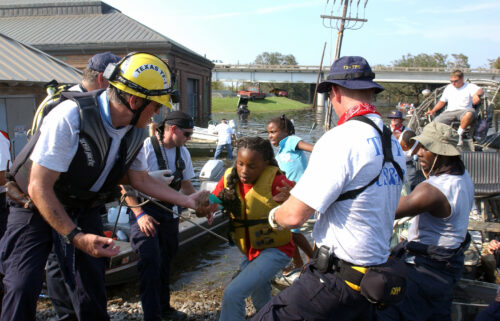Ruins from the 1906 San Francisco earthquake, remembered as one of the worst disasters in the history of the United States. Photo: H.D. Chadwick. NARA National Archives and Records Administration
Everybody has a plan until they get punched in the mouth.” — Mike Tyson
Disasters can strike at any time and cause significant damage, injury, or loss of life. In these uncertain times, the potential for civil unrest is also a reality we must all be prepared to face. Whether sparked by political discord, economic instability, or social tensions, civil unrest can occur suddenly and without warning. Emergency preparedness is crucial to effectively respond when the emergencies occur.
A well-crafted emergency preparedness plan is an essential aspect of preparedness. It is a set of steps and procedures for mitigating and responding to unexpected events that could cause harm. You are not prepared unless you have a plan. Although flexibility is essential, the time to plan is not when an emergency occurs.
PACE Planning Methodology
PACE (Primary, Alternate, Contingency and Emergency) is a planning methodology of preparing for different contingencies and reducing uncertainty. It involves creating three backup plans in case the main plan fails. The Primary plan is the first option, the Alternate plan is the second option, the Contingency plan is the third option, and the Emergency plan is the last resort. PACE planning is not complicated and is an integral aspect of emergency planning.
Developing an Emergency Preparedness Plan
Step 1: Identify Potential Risks and Vulnerabilities
The first step in developing an emergency preparedness plan is to identify potential risks and vulnerabilities relevant to your location and circumstances. This could include natural disasters like earthquakes, floods, or hurricanes, as well as man-made events like fires, power outages or civil unrest. Once potential risks and vulnerabilities are identified, they should be ranked based on their likelihood and potential impact. Create scenarios for each identified risk and develop corresponding response plans.
Stay informed about the potential hazards and risks in your area. Sign up for alerts and warnings from local authorities or agencies. Learn about the emergency plans and procedures of your workplace, school, or community. Participate in drills and exercises to practice your response skills.
Step 2: Create a Communication Plan
A communication plan is essential to ensure everyone knows what to do in an emergency. This should include emergency contact numbers, meeting points, and procedures for communicating with family members, colleagues, an out-of-town contact person who can relay messages, or emergency services.
Identify the Purpose: The first step is to identify the purpose of the communication plan. You need to ensure everyone knows to do in an emergency, to keep everyone informed about a situation, or to coordinate actions during an emergency.
Identify Key People: Identify all the people who need to be part of the communication plan. This could include family members, co-workers, emergency services, etc.
Decide on the Communication Methods: Decide on the methods of communication that will be used. This could involve phone calls, text messages, emails, social media, etc. Have a PACE communications plan in place.
Create a Contact List: Create a comprehensive contact list that includes all the necessary contact information for everyone. The American Red Cross has an Emergency Contact Card template that you can download: Download Template >>
Establish Roles and Responsibilities: Assign roles and responsibilities to everyone. Cover who will initiate the communication, who will respond, and who will be responsible for what actions.
Test the Plan: Once the communication plan has been developed, it should be tested to ensure it works effectively. This could involve a simulated emergency situation to test how well everyone understands and follows the plan.
Review and Update the Plan: The communication plan should be reviewed and updated regularly to ensure it remains effective and relevant. This could involve updating contact information, changing communication methods, or adjusting roles and responsibilities.
- Review and Update the Plan: The communication plan should be reviewed and updated regularly to ensure it remains effective and relevant. This could involve updating contact information, changing communication methods, or adjusting roles and responsibilities.
Step 3: Develop an Evacuation Plan
In any disaster or crisis, whether natural or man-made, there are two basic options — shelter in place or evacuation. The circumstance will determine the appropriate response.
Sheltering in place often means staying inside your home or another safe location until the situation resolves. When sheltering in place, it’s important to ensure you have sufficient supplies, such as food, water, and medical necessities. It’s also crucial to stay informed about the situation through reliable news sources and official updates.
Evacuation might be necessary if your location is directly threatened. It’s important to follow the guidance of local authorities and leave the area if an evacuation order is issued. In such cases, having a pre-planned evacuation route and a packed go bag can be lifesaving.
A go bag contains essential items needed to survive for at least 72 hours during an emergency. It is designed for situations that require immediate evacuation. The contents of a go bag vary based on personal needs and the type of emergencies common in your area.
An evacuation plan outlines the safest and quickest routes to leave your home or workplace in case of an emergency. It should also identify safe locations to regroup.
Creating an evacuation plan involves several steps:
Evaluate the Emergency: Assess the vulnerability of your location to specific emergencies.
Determine Exit Routes: Map out exit routes in the floor plans. A location must have at least two exit routes.
Identify Safe Areas: Determine locations of designated safe areas.
Prepare for Different Scenarios: Since the nature of an emergency can’t be known beforehand, prepare for different scenarios where individuals could be exposed to life-threatening danger.
Step 5: Regularly Review and Practice the Plan
Regularly reviewing and practicing the emergency plan ensures everyone knows what to do and can help identify any gaps or improvements needed in the plan.

Photo by Jocelyn Augustino/FEMA
FEMA Mobile App
The US Federal Emergency Management Agency (FEMA) offers a free mobile app that is a valuable tool for anyone looking to stay informed and prepared in the face of potential disasters. It offers a range of features designed to help users plan, protect, and recover, making it a must-have app for disaster preparedness and response. It is available for both iOS® and Android® devices.
One of the key features of the FEMA app is its ability to provide real-time weather and emergency alerts from the National Weather Service for up to five locations nationwide. This feature can be crucial in times of severe weather or other emergencies, providing users with timely information to help them make informed decisions about their safety.
In addition to weather alerts, the FEMA app also helps users find nearby shelters in case they need to evacuate to a safe space. This can be particularly useful in situations where individuals are displaced from their homes due to natural disasters or other emergencies.
The FEMA app also serves as a personalized disaster resource, empowering users to take charge of any disaster life throws their way. It provides guidance on how to prepare for common hazards, including creating a family emergency communication plan, what to pack in an emergency kit, and what to do immediately after a disaster.
The FEMA app has a recovery section that provides users with the tools they need to recover after a disaster. It helps users understand federal disaster declarations in their area and provides answers to common questions about the assistance application process.
The FEMA app is designed to be accessible to everyone. It is compatible with screen reader technology (Voice Over / TalkBack), follows federal accessibility requirements, and includes inclusive design principles such as consistent user interfaces, plain language, and ALT text descriptions.
Summary
Developing an emergency preparedness plan is a proactive measure that can significantly mitigate the impact of emergencies. Putting together a plan is only the first step. The key to effective emergency preparedness is not just having a plan, but regularly reviewing and practicing it.
Resources
FEMA
FEMA.gov
Ready
Ready.gov
American Red Cross
RedCross.org
*The views and opinions expressed on this website are solely those of the original authors and contributors. These views and opinions do not necessarily represent those of Spotter Up Magazine, the administrative staff, and/or any/all contributors to this site.

